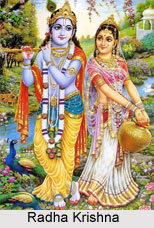 Vaishnava Padavali marked the golden period focusing on the Radha-Krishna legend. The poetic themes had spread as part of the religious Bhakti movement that projected an intense personal form of devotion. The traditional songs on the Radha-Krishna legend were popular with Chandidas (late 14th c.) in Birbhum. He was the earliest poets in the emerging Bengali language.
Vaishnava Padavali marked the golden period focusing on the Radha-Krishna legend. The poetic themes had spread as part of the religious Bhakti movement that projected an intense personal form of devotion. The traditional songs on the Radha-Krishna legend were popular with Chandidas (late 14th c.) in Birbhum. He was the earliest poets in the emerging Bengali language.
In 1474, Maladhar Basu had translated the 10th and 11th cantos of the Sanskrit Srimad Bhagavatam into the Bengali poem Srikrishnavijay. He focused on Krishna`s divine life.
Vaishnavism in Bengal was given the required boost by Chaitanya. The poets who belong to Padavali tradition included Murari Gupta, Narahari Sarkar, Basudev Ghosh, Lochandas, Jnanadas, Govindadas, Balaram Das, Syed Sultan and Dwija.
Seventeenth century witnessed the work of Kaviranjan, Kavishekhar, Radhaballabh Das, Ghanashyam Das and Ramgopal Das. In the eighteenth century Bengali Literature witnessed the works of Vaisnavadas, Chandrashekhar, Radhamohan Thakur, Narahari Chakravarty, Yadunandan, Jagadananda, Radhavallabh, Harivallabh, Ramgopal, Saiyad Marttuza and Alaol.
The subject matter is the love of Radha and Krishna, on the banks of RiverYamuna in Vrindavan, their secret meetings in the forests, Krishna`s charms and the love of the gopis for Krishna and so on. These poetries focus on the feelings of a woman in
love. Vaishnava Padavali left an ever lasting mark on Bengali literature.

This Krishna Radha Literature supplied the main impulse to Bengali love poetry. The major volume of the Vaishnava literature of Bengal was neither in Bengali nor in Sanskrit language. It is a mixture of Bengali and Maithili which came to be known as Vrajabuli.
The earlier Padavali writers regard Chaitanya as a god and refer to his activities in a manner that suggests the activities of Krishna in the Bhagavata. Lochan Das is noted for light colloquial touch. Narottam,Balaram Das, Jnandas and Govindadas Kaviraj and Chandidas are in the forefront of Pad-karttas. Jnandas writes in native Bengali tradition. Govindadas` verbal harmony, alliteration and other sound-effects make his poetry uncomparable.
The Padavali writers of eighteenth century have some attractive features though their compositions lack originality and on the whole echo the sentiment and music of their predecessors. The original impulse of Vaishnavism ran out in the eighteenth century thereby the Pada became stereotyped in form and content. Premdas, the brothers Chandrasekhar and Sasisekhar, Radhamohan Thakur, Narahari Chakravartti, and Dinabandhu Das were other writers of this tradition. The Pada writers took their material from the conventional Krishna Radha pastoral. However they took the matter with a poetic beauty, a passionate intensity and a spiritual meaning which was their own.
The content of the Pada is meagre and tenuous. Their main appeal is through their verbal music which is so compelling. It lacks the vitality to blossom into a concrete imagery. As far as representation of feelings and sentiments are concerned the Pada writers followed the Rasa tattwa, which was the exposition of the Vaishnava cult of love and devotion. The triviality and superficiality that is there in many of the Padas is partly traceable to the Rasa tattwa.
Pada writers wrote on themes which were pre-determined and fixed. Their choices of themes were stereotyped. They were allied to religion and they wrote abiding by the canons and conventions of their cult. An endless series of Padavali poems were written on the worn-out themes of Purbarag. The great defect is their crudeness, lack of detachment and intellectual abstraction. Sentiments are artificial. Their compositions are spoilt by jaded conventionalities taken from Sanskrit erotic literature.



















